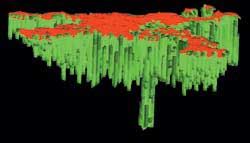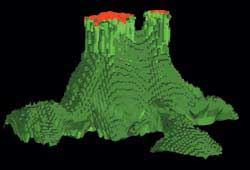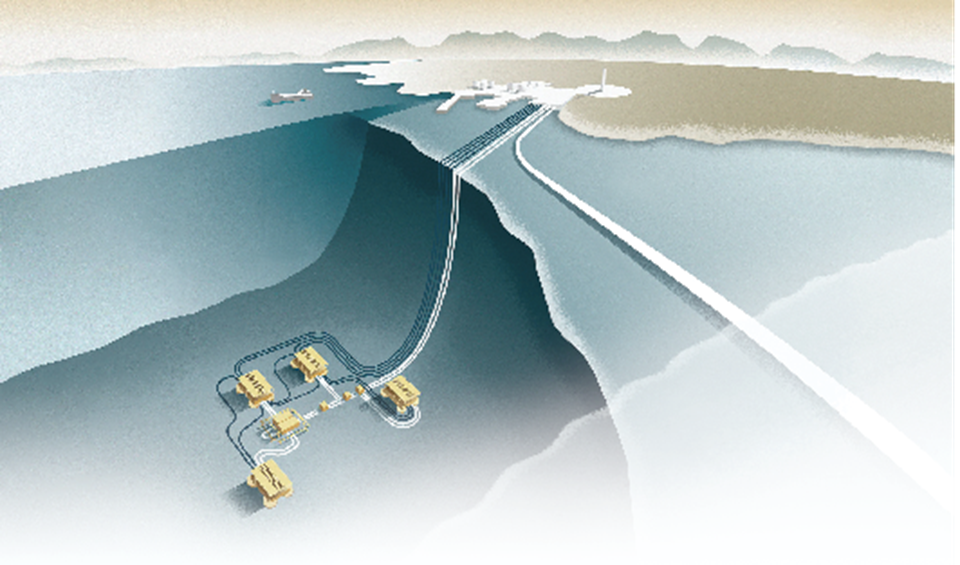
Photo: Rune Petter Ness
Carbon dioxide, or CO2, is currently at the heart of the world’s biggest headache, global warming. Fossil fuel combustion and other anthropogenic emissions release about six billion tonnes of carbon to the atmosphere each year.With global temperatures on the rise, and the spectre of widespread climate change on the horizon, more and more people are hoping that underground storage could prove to be a permanent solution to the problem. Gunnar Berge, director of the Norwegian Petroleum Directorate, thinks widespread CO2 storage in North Sea reservoirs is only a few years away.
Pumping CO2 into oil reservoirs also helps to extract more oil from wells, an additional point in its favour. The Petroleum Directorate has calculated that using CO2 in oil fields on the Norwegian shelf can potentially increase recovery rates by 240 – 320 million standard cubic metres of oil, increasing the value of the fields by as much as NOK 400 billion.
Bellona, an environmental group, also approves of this solution, pointing out that Norwegians already pump one million tonnes of CO2 a year into the rock formations of the Sleipner field. If storage can also be included in international CO2 quotas, fossil fuel could be used in virtually in the same way as renewable energy sources, and gas-fired power stations immediately become more appealing. But is this really as simple as it sounds?
ECONOMIC UNCERTAINTY
The answer is both yes and no, according to senior scientist Erik Lindeberg at SINTEF Petroleum Research. Lindeberg has studied underground CO2 sequestration for many years.
“If we are able to deal with CO2 by storing it, in some ways this would give us a new source of energy in terms of the remaining reserves of fossil fuels such as oil, coal and gas. But this means that we would have to find ways to manage the CO2”.
Since the process first came into use in the 1970s, American oil companies have been using CO2 to raise oil recovery rates, an approach that has improved rates by as much as 60% in some fields. The technique has not been widely adopted in Norway for a number of reasons. According to Lindeberg, the most important drawbacks are economic.
“Capturing CO2 from power stations and transporting it to disposal reservoirs is still so expensive that the value of the additional oil we could recover would not pay for more than half the costs involved in a typical oil-field”.

year 2021
MORE ATTRACTIVE STORAGE
Three main factors can change this situation. Higher oil prices will make it more profitable to extract remaining oil. Erik Lindeberg says that when oil prices were at their highest during the Iran- Iraq war in the 80s, profits were so high that plants were built to extract CO2 from flue gases in gas-fired power stations in the USA. Other factors include better technology, while approaches developed as a result of the Kyoto agreement could encourage us to find solutions for cheaper CO2 storage. At present, reducing CO2 emissions by injecting the gas into formations does not give a country credits under the international agreements aimed at reducing CO2 emissions.
“Perhaps they will count in the future. However, one prerequisite for obtaining credit, of course, is that the gas will remain underground long enough so that we can be sure that any gas that does leak out will not affect the climate in the future,” says Lindeberg.
RUNNING FROM THE BILL
The storage solution is so tempting that researchers all over the world are focussing their efforts on it. A five-year project led by SINTEF Petroleum Research is currently trying to determine how we can improve the ability of reservoirs to retain CO2 for long periods.
“We are not talking about just a few hundred years,” says Lindeberg. “It’s true that no present-day companies or people will be around to notice the effects of potential future emissions of greenhouse gases, but we cannot just continue to deplete our natural resources and leave the bill for our children to pay.”
Lindeberg has calculated that CO2 would have to stay underground for at least 10,000 years, to be on the safe side. That time scale allows for the gas to dissolve into reservoir fluids. The North Sea is a perfect storage site, with its many reservoirs sealed by clay shale.

year 2421
STABLE DEPOSITS
After production has come to an end, used-up oil and gas fields can both be used to store carbon dioxide. One advantage to this approach is that the extent and physical characteristics of the reservoirs have already been very thoroughly surveyed. But even though nature kept a tight grip on oil and gas until we began to extract it, it is possible that pumping CO2 back into the reservoir will disturb the sealing strata. For this reason, Lindeberg and his colleagues are looking into whether the gas is chemically affected by any types of minerals.
“CO2 has turned out to be more reactive than either oil or gas with well materials, which means that the way we currently seal wells is not necessarily safe enough. Here we can see that there is a need to develop new types of cement to replace those in use today”, he says.
Storing CO2 will have to be done in a formations made of sufficiently permeable rock types, such as sandstone, so that the gas can be pumped in easily. The rock also needs to be porous enough to provide storage room. At the same time, the porous stone must lie beneath a covering of impermeable rock to prevent the gas from gradually seeping up to the surface. It is extremely important that these formations be leak-proof. Lindeberg says this is the most important safety-related challenge.
BACK TO THE FUTURE

year 2621
Scientists depend on good physical and mathematical models to conduct their risk analyses. Statoil is already injecting a million tonnes of CO2 a year from its Sleipner field into a formation. The CO2 is separated from the oil and gas from the field.A number of companies and research institutions are watching the situation, and SINTEF is a member of an international project that is monitoring the behaviour of the CO2. Since it is still too early to determine the long-term effects, we must depend on assumptions based derived from models. Erik Lindeberg turns on his PC and launches a simulation. A section of a reservoir is shown in blue on the screen.
The simulation shows as CO2 is pumped in for several years until the process is stopped, but the CO2 continues to disperse under the seal. Since CO2 is lighter than water, it will migrate to the top of a water-filled formation, spreading out like a blanket under the ceiling rock strata, until it gradually dissolves in the water. Seven thousand years after we have stopped pumping in CO2 it is almost gone. A new simulation shows that CO2 dissolved in water sinks down into the water column below it, is mixed into it and finally disappears. We have ‘fast-forwarded’ 10,000 years in 20 seconds, and when all the CO2 has dissolved, major emissions of greenhouse gas from the storage reservoir are no longer a risk.
REAL-TIME 3D
In their hunt for methods to qualify a formation as a potential repository, scientists are employing a combination of methods borrowed from reservoir technology, geology and seismics to evaluate the bedrock, compare conditions between wells, find structures that

year 5019
might be suitable for storage, and identify possible escape routes for the gas.
“We already have enormous quantities of data regarding the conditions under the North Sea, and we are among the world leaders in terms of our knowledge of oil and gas recovery. This is what we will base our future work on. With the aid of 3D seismics, for example, we can follow the CO2 beneath the surface in real time.We can look at where and how it is forced into the reservoir and what happens to oil and gas when we use CO2 to enhance oil rcovery,” says Lindeberg.
“This will enable us to calibrate our reservoir models and improve our predictions about the final fate of the CO2 in the far future.”
A VALUABLE RESOURCE
CO2 may seem like a problem – but in certain circumstances, it can also be turned into cash.
“Until now, we have been using water or natural gas as the injection substance to extract as much oil as possible out of our reservoirs. But natural gas itself is a source of revenue, and it turns out that water is not an ideal injection medium. When a reservoir is full of water we can no longer produce oil from it, even if we have only brought up 40 – 60% of the oil it contains.” “This makes it both tempting and financially attractive to use CO2 to produce more oil from the reservoirs,” says Lindeberg, as he proceeds to list it’s the greenhouse gas’s advantages.

year 7018
It is just about as heavy as oil, which means that it pushes the oil ahead of itself, without sneaking past it like natural gas or water, which tend to pass over or under the oil. CO2 makes the oil more fluid, and under certain conditions, it can actually wash all of the oil out of the pores in the rock. Lindeberg estimates that we would be able to recover between five and twenty percent more of our reserves if we adopted this technique.
SERIOUS NEED
However, there is a problem: we would need to inject at least five million tonnes of CO2 a year into a medium-sized field for ten years to have any effect. In comparison, a 400 WM gas-fired power station produces around 1.1 million tonnes of CO2 a year. Ironically, this means that we do not have enough CO2 available to implement worthwhile projects.
“We no not produce nearly enough CO2 here in Norway. This would be a suitable technology for countries with major, highly localised emissions of carbon dioxide, from coal-fired power stations, for example.
Another solution would be for us to take CO2 from power stations in the UK or Denmark. The gas could be transported by pipeline to fields in the North Sea for injection and storage there,” says Lindeberg. Such a concept requires the consideration of climatic and resource issues in decision-making.
COMPLICATED PUZZLE“If we are capable of dealing with CO2 by storage, this would
give us in one sense a new source of energy from what remains
of fossil fuels such as oil, coal and gas.
“If we are capable of dealing with CO2 by storage, this would
give us in one sense a new source of energy from what remains
of fossil fuels such as oil, coal and gas.
Starting up a largescale CO2 storage project on the Norwegian continental shelf is no simple matter – even if we could be sure that there would be no leaks. First, technical, economic and legal evaluations would have to be carried out. Such a project would also require a joint infrastructure for transport and storage to collect CO2 from the utility sector and other point sources. Just as natural gas is transported to the Continent by pipeline today, in the future we could bring CO2 back to the reservoirs in the same way. In some places, however,where sources are widely distributed, the pipeline system would be unsuitable, so transporting liquified CO2 by ship might be a solution.
Gunnar Berge, the director of the Norwegian Petroleum Directorate, said at the Environmental Forum Conference last autumn that enhanced oil recovery has great potential on the Norwegian continental shelf and could be profitable in socio-economics terms when environmental factors are considered. The technique could have important downstream effects in terms of employment and added value in Norway – once we have solved the challenges the technology poses.
Other sources: Environmental Report 2003; Ministry of Petroleum and Energy; Lecture by Gunnar Berge at the Environmntal Forum, November 2003; www.bellona.no; Chief scientist Torleif Holt, SINTEF Petroleum Research.
SLEIPNER WEST
Every day, some 2800 tonnes of CO2 are separated from the natural gas that is produced from the Sleipner field. Instead of being released to the atmosphere, the CO2 is pumped into the Utsira sandstone formation for storage, 1000 metres below the seabed in water-bearing formations. This adds up to about a million tonnes a year.
CO2 that is pumped into the formation does actually stay there rather than leaking out, according to findings from 2000. The cost of this sort of storage is relatively high. However, the alternative would be to pay NOK 1 million a year in CO2 taxes to the Norwegian government if the greenhouse gas were to be released to the atmosphere. By injecting CO2 into the reservoir, the costs are about the same, but the outcome is more environmentally friendly.
The post Basically good? appeared first on Geminiresearchnews.com.

